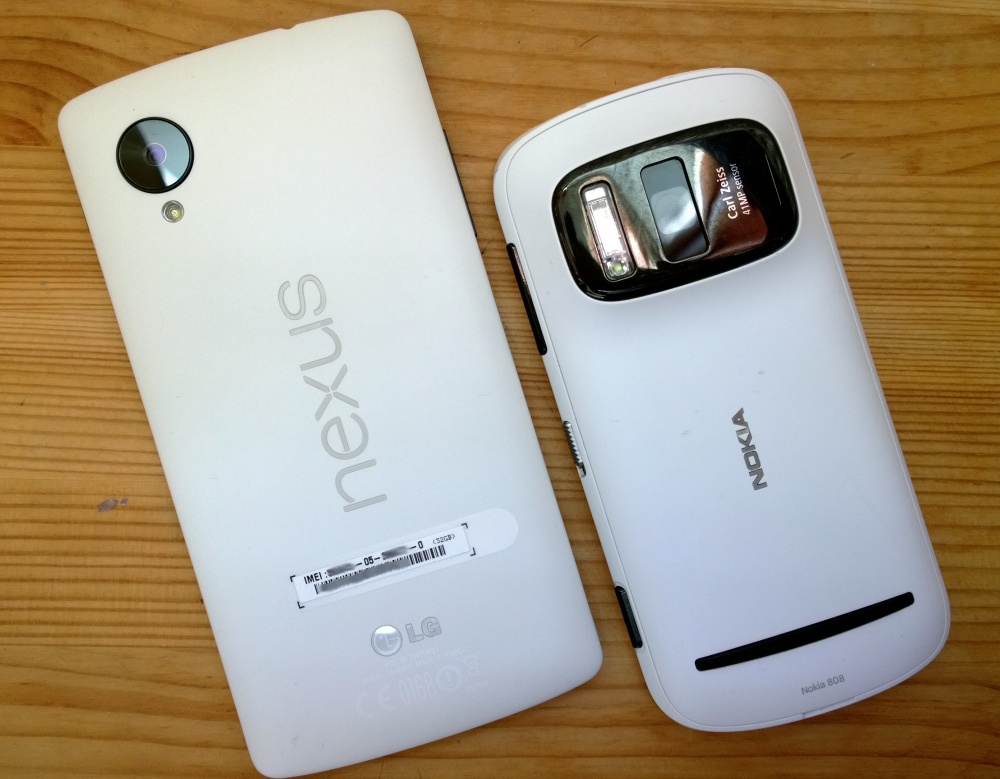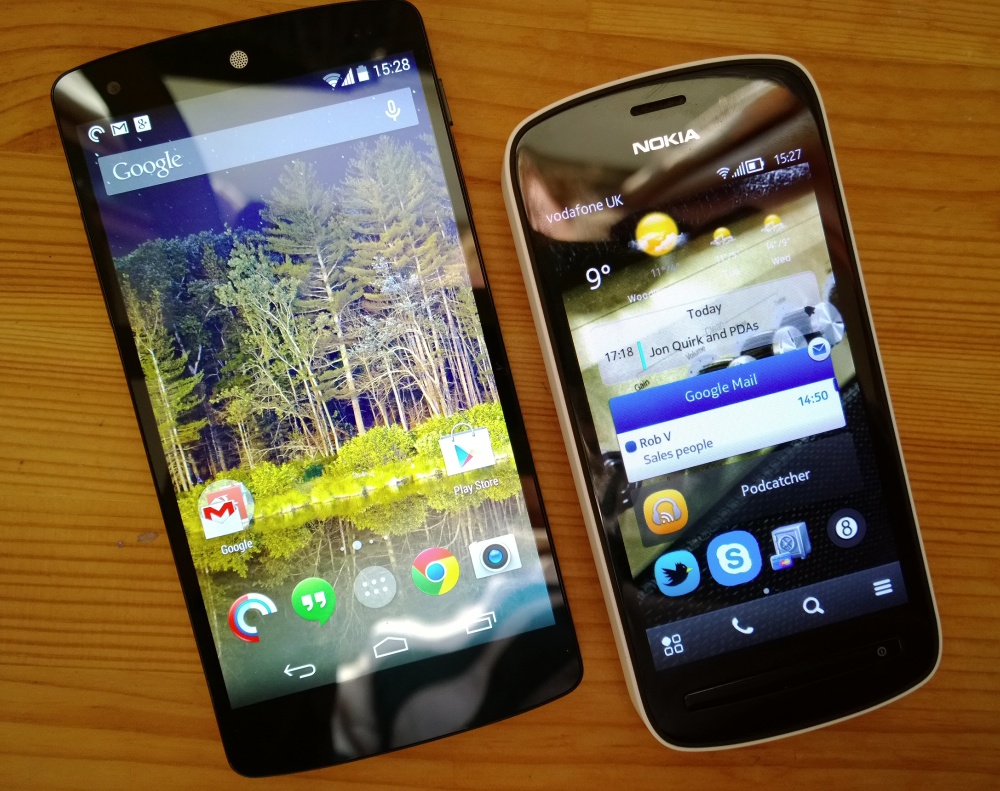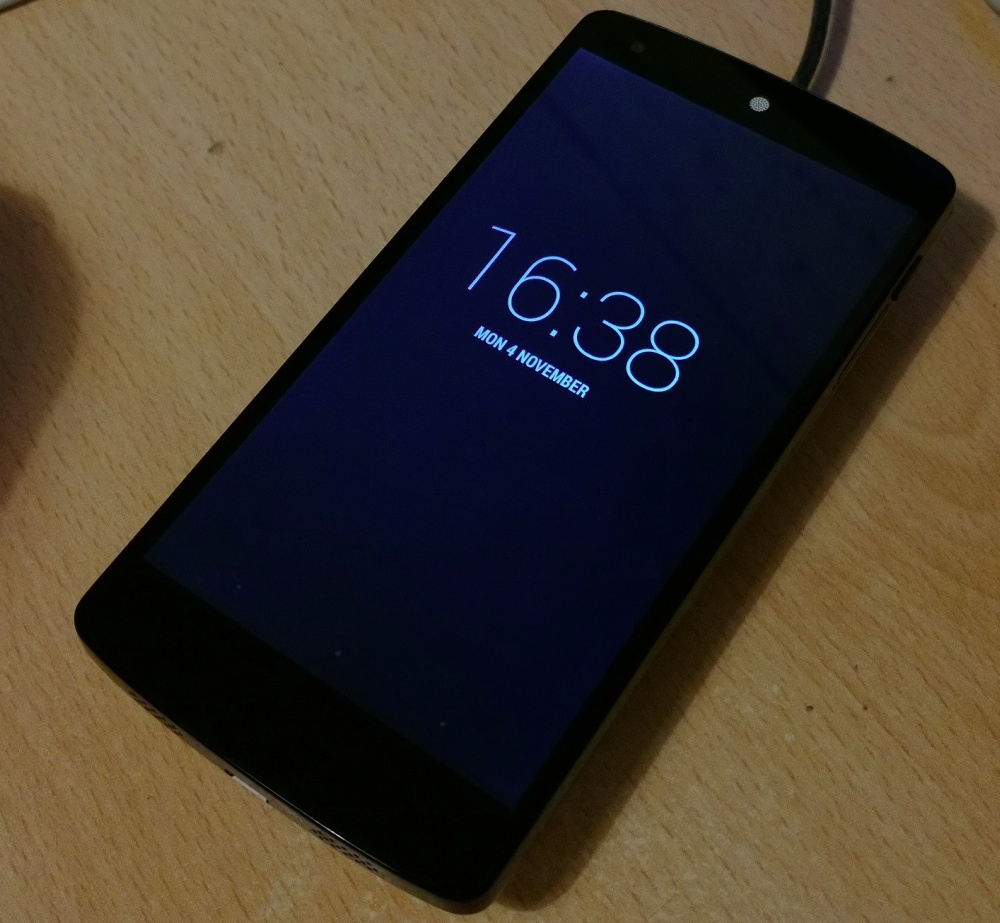Even as the most hardened Symbian fan, the continued moves by Nokia to withdraw support, the cessation of firmware updates and patches across the board and the imminent buy out by Microsoft, which has precisely zero incentive to prop up Symbian any more then it has to, all point to the advisability of lining up the next smartphone platform to jump to. Yes, many of us will hang onto our Nokia 808s and E7s, and so on, as long as is practical, but it always pays to look ahead too - to have a plan.
Having addressed the pros and cons of a switch to Windows Phone 8 (at least, on the Lumia 1020), it's time to turn to the next major smartphone platform - in fact, the dominant one by marketshare, though the fragmentation in the Android world is such that you can have five devices from five different manufacturers, all of which have slightly different user interfaces, menu structures and applications. With this in mind, I've recommended for ages that people stick to the 'stock' Android devices, the Nexus range, direct from Google.
This is a timely feature too, with the Nexus 5 arriving on the High Street in the last few days. Here's the white Nexus 5 with my white Nokia 808 from the Symbian world:

Cool, eh? But how practical is it to switch from one to the other? If you didn't fancy Windows Phone 8, is Android the way forwards for Symbian users?
As you'll have spotted from the title, the key is multitasking. Symbian, famously, had full multitasking, meaning that applications could all run at the same time. I often found applications in my multitasking carousel that I'd started a fortnight ago and had forgotten about - yet there they were, at exactly the same point in the UI and waiting for my input - or doing whatever it was supposed to do.
And this is the point. A smartphone needs to be fully intelligent and to do as much as possible for the user automatically, without needing babysitting or micromanagement. As a bare minimum, I'd expect the following to all happen automatically, unattended, with no input from me:
- Email collection
- Social network update collection
- Podcast checking and downloading
- Skype status maintained, ready for an incoming IM or call
- Weather forecast updates
And so on. One of the issues with Windows Phone 8 is that not all the above work reliably (yet) - once an application slips out of the 'running' (for which read 'frozen') list of recent apps, it's oh so easy for operation to be compromised. Meaning missed Skype calls, podcasts left un-downloaded, weather forecasts out of date, social networks looking as they did yesterday, and so on.
Android, in theory, promises multitasking in much the same vein as Symbian, so perhaps all this will work better on the likes of the Nexus 5 here?

The Nexus 5 and Nokia 808, shot in a bright sunny room (as you can tell from the reflections) - contrast and visibility on the Android device is certainly competitive, even when the sun is shining.
Form factor
One of the obvious differences diving into the Android world is that of size - although it's possible to get a wide variety of Android smartphones wirh smaller, Symbian-like form factors, the specifications are usually so modest that in terms of raw performance you don't gain anything over the likes of the Nokia 701 and 808. Still, prices are low too, sometimes under £200 SIM free. But, if you're going to go Android, why not start with the poster child of the OS - the 5" screened Nexus 5 (with a skinned version available as the LG G2 and with the Samsung Galaxy S4 and HTC One being similar in specs and in the hand)?
Although a 5" screen would have seemed too big back in the days of (for example) the N97/5800, the screen diagonal sweet spot has been rising over the last few years thanks to much thinner bezels all round and thanks to thinner devices generally. Holding the 4"-screened Nokia X7 or E7 in one hand and the 5"-screened Nexus 5 in the other, the overall perception of size (in terms of how easy the device is to hold and use) isn't that different.
(Of course, Android phones can go further, with 5.7 and 6.3"-screened form factors from Samsung, for example, but these can't reall be considered as phone replacements within the scope of this particular article.)
Performance, multitasking
Leaving aside benchmarks, which are almost completely artificial, it's perfectly valid to compare the day to day experience on Symbian and on modern Android. Although navigating around Symbian (especially on the speedy Delight custom firmware) can be pretty quick on the Nokia 808 and 701, opening applications can take a second or so and opening emails several seconds. Even with judicious set-up of the homescreen and using the multitasking carousel, the speed of Symbian is rarely jaw dropping. Web browsing is the biggest sluggard on the platform (I'm assuming you ditched Nokia Social a long time ago) and Chrome on the Nexus 5 is almost as fast as web browsing on a desktop - the comparison for this one function with Symbian is, to be fair, like day and night.
Although Android doesn't have a multitasking view per se, it does have a 'Recent apps' list which can be called up with one tap. You can think of this vertically scrolling carousel as a multitasking view, mind you, and with 1500MB of RAM free after booting, the Nexus 5 isn't going to need to close any applications down through lack of memory - so, effectively, whatever's been run recently will still be running unless you closed it (inside the application, or using a task killer utility). And, yes, tapping on something in this list, or tapping on a homescreen shortcut, brings up the application instantly.
In short, although the nuts and bolts of getting around a smartphone UI aren't that different in speed and flexibility, the worst speed culprits on Symbian are completely avoided, with Chrome and Gmail blazingly responsive here on the Nexus 5.
Day to day use and text input
The much-loved always-on AMOLED clock from the Nokia N8/C7/808 etc is a welcome part of the Symbian experience - and it's mostly absent here, mainly thanks to the use of a LCD screen. Yes, Nokia made always-on clocks work on the LCD-screened Lumia 920, but it's tricky voodoo to get right. I say 'mostly' here because there's a 'Daydream' always on clock which appears when the Nexus 5 is docked or charging, with time and date. But, on battery, you still have to reach over and press the screen/power button - so definitely a small step back here.
As a big fan of Google Now on Android, I did put up a piece looking at replicating some of its ideas on Symbian, but there's no substitute for the real thing, and Google Now has been enhanced yet again for Android 4.4, with its own dedicated pane on the homescreen system and with better voice recognition, you really can ask it almost anything in conversational English and get a meaningful response - always a cool demo, especially when the answers are spoken back to you.
My rails against the Symbian Belle FP2 keyboard have been legendary - I hate it so much, with no auto-correction, that I even switched to Swype, which did auto correct - and found that I quite enjoyed the experience in portrait mode. Moving from either to the slick input experience on modern stock Android is eye opening, though. Not only is there fabulous auto text correction for typos, 'swype' style gestures are also accepted, so you can mix and match, plus there's genuine voice transcription in many applications and situations (assuming your environment is quiet enough).
Simply no contest on the input front and, whatever input system you preferred on Symbian, you'll find things better on Android, especially on fast stock devices like this.
Photography
Imaging has, of course, been something of a Nokia and Symbian speciality, though this feature isn't so much about cameras. After all, the majority of Symbian handsets still in use probably have EDoF units. The camera in the Nexus 5 is on a par with the best from Samsung and is very similar to the unit in LG's own G2, so excellent images in most light conditions, even at night, thanks to the OIS here, with only Xenon flash missing from the equation. N8 and 808 owners will miss that, in a big way, of course. For the general Symbian user though - think E7, C7, 702, E6 - the camera in a modern Android phone like this will be a definite step forwards.
Internet and PIM
Web on Symbian is something of a known (and rather reviled) quantity, being slow (partly thanks to slow javascript handling, party due to the processors in most Symbian phones) and unfinished (e.g. no full-screen mode). As you'd expect, the Internet experience is smoother and faster on Android by some margin. Web browsing is handled by Chrome, working very fast (4 seconds to render the full New York Times web page) and syncing tabs and history to your desktop. Other browsers are available in the Play Store, if you want to experiment further.
Email is slicker too, in that message rendering with 'rich' content is nearly instantaneous, you can have more than one Mail for Exchange account and the Gmail experience, by definition, is second to none - it's all of Gmail in your pocket, etc. Along with email come contacts and calendar sync, of course, via CardDAV and CalDAV, syncing immediately to the Google/Gmail cloud, while Symbian currently has to make do with syncing to outlook.com or accessing Google PIM via a third party like Nuevasync.
Social
Ignoring Nokia Social and its plug-ins (into Gallery), Symbian is completely reliant on third party social clients - and the same is true, funnily enough, for Android, at least in this stock incarnation. Having said that, the first party clients for Twitter, Facebook, LinkedIn, Evernote, and so on are excellent, with full integration into Android's sharing system. Symbian doesn't fare too badly for Twitter, with the likes of Gravity and Tweetian, but the range of Android Twitter clients is vast. And, wonderful though Notekeeper is for Symbian, having an all-singing, all-dancing Evernote client here on the Nexus 5 is wonderful.
Navigation
Given all the above, it's time to put a little balance back towards Symbian - if you move to Android, you will have to sacrifice the convenience of true offline navigation - Google Navigation can cache small areas of maps, but can't cope with whole countries and can't plan routes at all without an Internet connection. When it's working, it's very competitive with Nokia Drive on Symbian and with the benefit of a far better points of interest and place search system - but if you want to venture outside of decent cell connectivity then you'll need to budget for a commercial Android navigation software suite.
Mind you, Viewranger now works on Android too, so really hard core hikers and bikers can still get their mapping fix.
Multimedia
Symbian's range of video codecs/compatibility is pretty good, but modern competing operating systems match it, at least in terms of my video collection, all of which played perfectly on Android 4.4. The Android virtual controls get out of the way when playing back videos (or browsing photos) and seeing my 720p movies at full resolution on a 5" screen bears no comparison to Symbian's brave nHD downsampled version!
One area where you may struggle is when listening to podcasts or music or videos over the built-in speaker. The Nexus 5's speaker is somewhat quieter than even a Nokia C7's, so some way short of that on the N8 or 808 - it's not tinny, but it's certainly not loud. Which means that you'll need a Bluetooth or plug-in speaker for listening in a big room and you'll probably need a car kit when using sat-nav in a car moving at speed. Not that loud speakers are the exclusive province of Symbian - we've seen the HTC One in the Android world with speakers that match the 808 - and there are two of them(!)
One staple of Symbian which hasn't been matched yet on Android is 'Play via Radio' (FM transmitter), which is a shame. Mind you, the Bluetooth support is now excellent in Android (finally) and all car kits should now work without issue. And, as I've verified, you can pick up a really good 3.5mm FM transmitter accessory from the likes of Amazon for less than £10, if you really, really want to take this functionality with you.
Apps and games
With applications starting to disappear from the Nokia Store, with no new apps or updates being accepted and with the app ecosystem not being particularly well filled out in the first place, the third party app scene on Symbian has never been at a lower ebb. DIY approaches like my app and game directories are only stop gaps for enthusiasts, of course. All a great shame.
Needless to say, moving to Android solves the application problem in a huge way, with the best part of a million titles available. Quite literally something for everyone in the Google Play Store - and often two or twenty or two hundred items that fit a particular bill.
Particular apps of note: Podcatcher users on Symbian should head for Pocket Casts on Android, very similar and more reliable. Handy Safe users should head for the open source KeePass 2 - tutorial coming soon.

Battery life, charging
Battery life on Android is, based on my experiences over the last few years, not quite as good as that on Symbian, which has a lower standby drain. But you'd be hard pushed to compare the two operating systems directly because the use case for the two are different, for most people. With a 5" screen and full YouTube, BBC iPlayer and Netflix clients, for example, you'll spend more of the day consuming video. Add in ten times more games and you can see that the typical Symbian phone/converged-device use case uses battery power very differently on the whole.
At least battery sizes have risen in the wider smartphone world in recent years. The 1500mAh 'hero' battery (BP-4L) that we used to coo over back in 2008-2011 has been, by necessity, trumped by batteries in the 2000-3500mAh range in modern Android smartphones - the aim always being to get you through a full day on a single charge - but no more.
The ace up the Nexus 5's sleeve here is something that never made it to Symbian at all - Qi wireless charging, just as on a couple of the Nokia Lumias - in fact, my Nexus 5 charges beautifully on the Nokia Qi charging pad. With charging this trivial, it makes it practical to keep your smartphone at 100% charge almost every time you pick it up, without worrying about wear and tear on microUSB connectors.
Don't assume that all Android devices have wireless charging, mind you - it's limited to only a handful of models at the moment.
Verdict
Writing these 'transition' articles is bitter sweet, as you can imagine. Symbian has been my tech life for the last decade and there are still aspects of Symbian OS and the Nokia hardware than runs it that are unique and which will ensure that I'm not parting with my N8/E7/808/E6 etc. for love nor money.
But at the same time, Android 4.4, implemented on hardware like this Nexus 5, is patently more 'modern', a million times better supported by services and developers, and the likes of the Nexus 5 would indeed be a fairly easy move - from one multitasking phone OS to another!
